If you do not want to use the "Microsoft Network Client 3.0 for DOS" to create a DOS-boot
floppy, you can create a boot-floppy from a Windows 95/98 installation, allowing to establish a
network connection to another windows system (Windows 95/98 or NT4 workstation or server)
using NetBEUI and IPX/SPX protocol (this method can NOT be used to connect via TCP/IP ! )
Windows95/98 network drivers will read the configuration from the Windows registry, to be more
specific: from the file SYSTEM.DAT, and that file is usually greater than 4 MByte and will NOT fit
onto a floppy. However it is possible to extract the registry keys containing the network configuration
from the Windows registry and create a new SYSTEM.DAT of just a few Kbyte, which will fit onto
a floppy disk together with all other required network drivers.
Warning:
The next steps will require to work in the Windows registry, so please make FIRST a backup of
the Registry files SYSTEM.DAT and USER.DAT, allowing you to recover the Windows95/98
system in case on of the following steps damages/destroys your registry files ! |
Start REGEDIT and locate the key:
HKEY_LOCAL_MACHINE\System\CurrentControlSet\Control\ComputerName\ComputerName :

 | Make sure, that the key is selected in
the tree-view on the left side of
REGEDIT, then select from the menu:
"Registry" / "Export Registry File". |
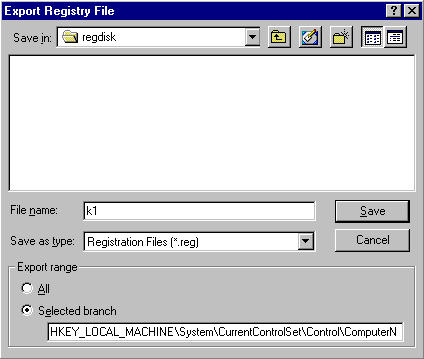 | Store the selected Registry key as file
K1 (it will add the appendix REG) to a
previously created directory
(I use in this example: C:\REGDISK). |
repeat this procedure for the following registry keys:
HKEY_LOCAL_MACHINE\System\CurrentControlSet\Services\VxD, store as K2.REG :

HKEY_LOCAL_MACHINE\Network\Logon, store as K3.REG
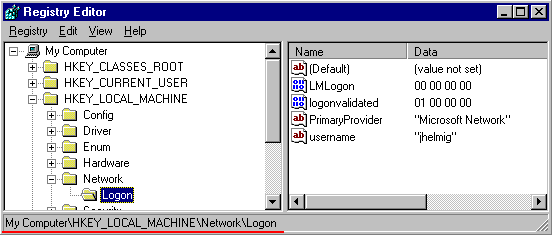
HKEY_LOCAL_MACHINE\Software\Microsoft\Windows\CurrentVersion\Network, as file K4.REG
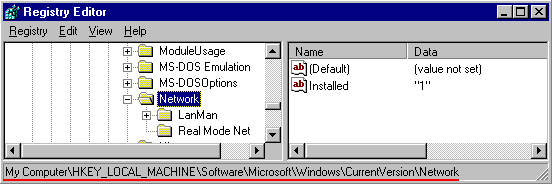
 | You need to edit the files K2.REG, K3.REG and K4.REG
( NOT the file K1.REG ! ) |
At the top of the file is the keyword "REGEDIT4":

erase that keyword "REGEDIT4", then save the file.

You need to combine the 4 files K1.REG, K2.REG, K3.REG ane K4.REG into a single
REG-file: please open a command-prompt window ("MS-DOS Prompt") , change to the
directory where the REG-files are stored (in my example C:\REGDISK ) and type the
command:
copy K1.reg + K2.reg + k3.reg + k4.reg kall.reg

( if you insist on using the Windows GUI: copy/paste the content of K2.REG to the end of K1.REG,
then copy/paste K3.REG and K4.REG to the end of K1.REG )
You now need to convert this combined REG-file into a new SYSTEM.DAT :
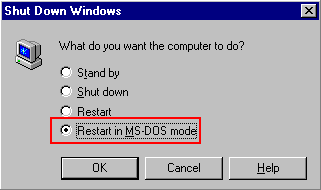 | It can NOT be done within the Windows GUI
or inside a Command-prompt ( "MS-DOS Prompt")
window, you MUST restart in MS-DOS mode. |
Change to the directory, where the REG-files are stored.
You can ask for the available command-line parameter of REGEDIT : REGEDIT /?
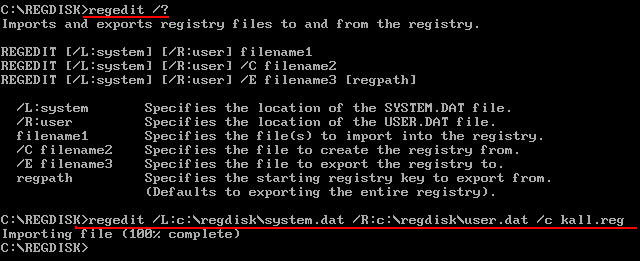
Type the command (assuming that your directory is C:\REGDISK ):
regedit /L:c:\regdisk\system.dat /R:c:\regdisk\user.dat /c kall.reg
IMPORTANT NOTE: although we only need to create a new SYSTEM.DAT (using the
"L"-command line parameter) , you MUST also define the path for a new USER.DAT (using
the "R"-command line parameter) , otherwise this REGEDIT-command will overwrite your current
USER.DAT in your Windows-directory and your Windows systems will now start anymore !
( did you make the backup of your registry files ? ) |
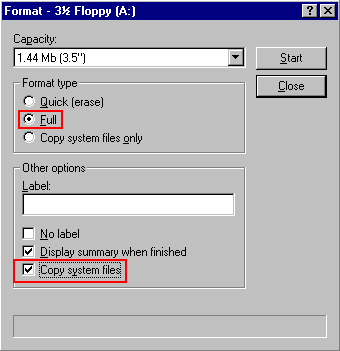 | Restart your Windows System and
format a floppy with system-files
(to be able to boot from it) either
using the properties of the floppy-disk
drive or an MS-DOS Prompt Window:
|
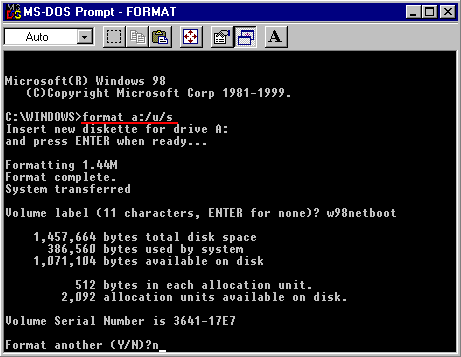
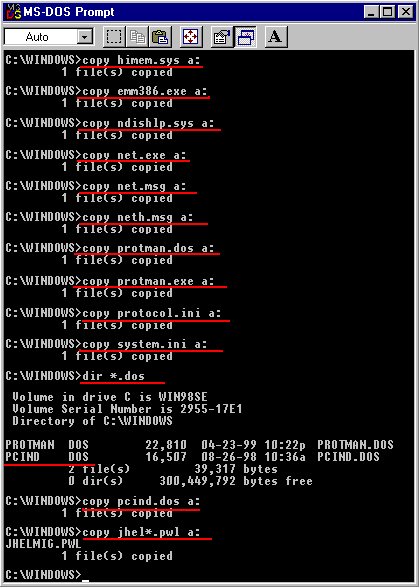 | You need to copy now the following
files from your Windows directory
(usually: C:\WINDOWS ) to the
floppy disk:
- HIMEM.SYS
- EMM386.EXE
- NDISHLP.SYS
- NET.EXE
- NET.MSG
- PROTMAN.DOS
- PROTMAN.EXE
- PROTOCOL.INI
- SYSTEM.INI
in addition, the 16-bit (Real-Mode)
driver for your network card:
look in your Windows directory
for all file with appendix DOS,
there should be only one in addition
to PROTMAN.DOS, copy it also,
in my example: PCIND.DOS
(if you have more than one, then you may
have used different network cards in your
system, copy all of them, they are usually
small files)
copy also the password-file
(PWL-file) for your user login. |
 | copy the SYSTEM.DAT (created above)
to the floppy. Since it is a hidden file,you
will need to unhide it first
( using the ATTRIB-command) |
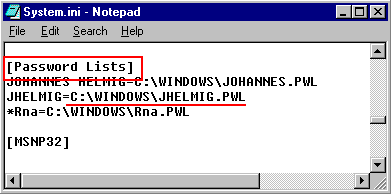 | You need to make a change to the
SYSTEM.INI on the floppy:
display it in an editor (like NOTEPAD)
and search for the section:
[Password Lists] |
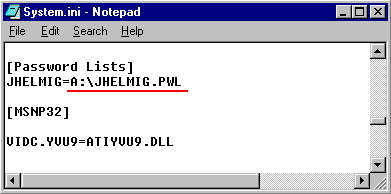 | You will need just the entry for the
PWL-files copied to the floppy disk,
adjust the path to point to the
floppy disk ( "A:\" )
Store the modified SYSTEM.INI
back to the floppy disk. |
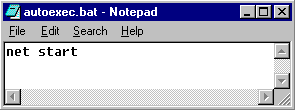 | create an AUTOEXEC.BAT for the
floppy disk |
 | create a CONFIG.SYS for the
floppy disk:
You need to use enter the driver-name
for your specific network card,
the one copied to the floppy disk
( in the step above ) |
The Windows Boot-floppy with network support is ready,
there is some space left to copy some required utility programs onto it, like:
- FDISK.EXE, FORMAT.EXE and an editor like EDIT.COM:

You can now boot from this floppy disk, it will load the network drivers.
once you are at the command-prompt, you need to start the WORKSTATION module
of the network, which will handle also the logon to the network:

Then, you can connect to another Windows system (like an NT-server) by mapping a
network-drive using the NET-command:
NET USE <drive-character:> <\\<servername>\<sharename>
 | example:
the connection to this system listed
in the "Network Neighborhood":
net use f: \\P120_home\c-drive |
About Johannes Helmig
Dr.Johannes
Helmig is working as Director, Technical Knowledge Management in the
Belgium office of Gerber Technology where he is involved in Customer
Service and internal training, with special interest in Networking.
Click here for Johannes Helmig's section.
Check out these recent articles by Johannes Helmig
-
Dec 01, 2003,
About the new Windows XP Professional Logon Screen : New XP style or NT4/2000 style
-
Nov 27, 2003,
Windows 2000 DCC and ICS
-
Nov 14, 2003,
Windows 2000 / XP WNTIPCFG
-
Oct 27, 2003,
Connecting Windows XP to Multiple Networks: Office and Home
-
Sep 16, 2003,
Windows 2000 Network Sharing
Click here for more articles by Johannes Helmig.
Get new article updates in your Inbox
Get all the various Windows networking related articles about
setting up Windows NT/XP/2000/2003 networks, troubleshooting,
connectivity and more delivered directly to your mailbox as and when
they are released on WindowsNetworking.com. Choose between receiving
instant updates with the Real-Time Article Update, or a monthly summary
with the Monthly Article Update.
* Please note that we do NOT sell or rent the email addresses belonging to our subscribers; we respect your privacy!
 Featured Links*
Featured Links*

